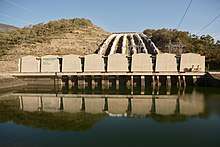Talbingo Dam
Talbingo Dam is a major ungated rock fill with clay core embankment dam with concrete chute spillway across the Tumut River upstream of Talbingo in the Snowy Mountains region of New South Wales, Australia. The impounded reservoir is called Talbingo Reservoir.
| Talbingo Dam | |
|---|---|
Talbingo Dam, in 2005. | |
 Location of the Talbingo Dam in New South Wales | |
| Country | Australia |
| Location | Snowy Mountains, New South Wales |
| Coordinates | 35°36′54″S 148°18′04″E |
| Status | Operational |
| Construction began | 1968 |
| Opening date | 1971 |
| Owner(s) | Snowy Hydro |
| Dam and spillways | |
| Type of dam | Embankment dam |
| Impounds | Tumut River |
| Height | 162 metres (531 ft) |
| Length | 701 metres (2,300 ft) |
| Dam volume | 14.488 million cubic metres (511.6×106 cu ft) |
| Spillways | 1 |
| Spillway type | Concrete chute |
| Spillway capacity | 4,290 cubic metres per second (151,000 cu ft/s) |
| Reservoir | |
| Creates | Talbingo Reservoir |
| Total capacity | 921,400 megalitres (32,540×106 cu ft) |
| Catchment area | 1,093 square kilometres (422 sq mi) |
| Surface area | 1,935.5 hectares (4,783 acres) |
| Maximum water depth | 110 metres (360 ft) |
| Power Station | |
| Operator(s) | Snowy Hydro |
| Commission date | 1973 |
| Type | Pumped-storage |
| Hydraulic head | 150.9 metres (495 ft) |
| Turbines | 6 |
| Installed capacity | 1,500 megawatts (2,000,000 hp) |
| Website Snowy Hydro at www.snowyhydro.com.au | |
History
The structure was completed by Thiess Brothers in 1971,[1] and is one of the sixteen major dams that comprise the Snowy Mountains Scheme, a vast hydroelectricity and irrigation complex constructed in south-east Australia between 1949 and 1974 that is now run by Snowy Hydro.
Location and features
Talbingo Dam is a major dam on the Tumut River, within the Snowy Mountains, approximately 5 kilometres (3.1 mi) south of the village of Talbingo. The dam was constructed by Thiess Bros Pty Limited and, at the time, the project was the largest dam ever built in Australia.[2][3] The dam is the largest and last of the sixteen dams completed as part of the Snowy Mountains Scheme.[4]
The dam wall comprising 14,488,000 cubic metres (511,600,000 cu ft) of rockfill with an upstream sloping silty clay core is 162 metres (531 ft) high and is 701 metres (2,300 ft) long. At 100% capacity the dam wall holds back 920,000 megalitres (32,000×106 cu ft) of water at an average depth of 70 metres (230 ft). The surface area of Talbingo Reservoir is 1,935.5 hectares (4,783 acres) and the catchment area is 1,093 square kilometres (422 sq mi). The spillway is capable of discharging 4,290 cubic metres per second (151,000 cu ft/s).[5]
Power generation

Directly downstream of the dam wall is Tumut 3, a pumped-storage hydroelectric power station, that has six turbine generators (3 of which double as the station's water pumps) with a total generating capacity of 1,500 megawatts (2,000,000 hp) of electricity; with a net generation of 812 gigawatt-hours (2,920 TJ) per annum. The power station has 150.9 metres (495 ft) rated hydraulic head, which flows into the station from 6 large pressure pipes (one for each turbine) from a concrete inlet structure at the edge of the reservoir, built about midway between the proper Talbingo dam and its spillway. The inlet structure can be mistaken by tourists for being the main dam, due to being a far more conspicuous sight from the road that leads into the Talbingo Dam/Tumut 3 complex. The pumps draw water from Jounama Pondage at the rate of 297 cubic metres per second (10,500 cu ft/s), returning water to Talbingo Reservoir for later generation use in periods of peak-demand.[6] The power generated at Tumut 3 serves both New South Wales and Victoria.[7]
Recreation
The reservoir is a popular area for fishing; inclusive of Brown Trout, Rainbow Trout, Golden Perch, Macquarie Perch, Redfin, and Trout Cod. Power boating is permitted.[8]
Camping is permitted in Kosciuszko National Park.[8]
See also
References
- "Thiess, Sir Leslie Charles (Les) (1909–1992)". Australian Dictionary of Biography. Retrieved 3 January 2019.
- Watkins, Robert (2011). A face in the crowd (Ebook). USA: Xlibris Corporation. pp. 51–56. ISBN 978-1-4568-3808-9. Retrieved 2 May 2013.
- Adikari, G. S. N.; Parkin, A. K. (1982). "Deformation behaviour of Talbingo Dam". International Journal for Numerical and Analytical Methods in Geomechanics. 6 (3): 353–382. doi:10.1002/nag.1610060307.
- Muirhead, K. J. (1981). "Seismicity induced by the filling of the Talbingo reservoir". Journal of the Geological Society of Australia. 28 (3–4): 291–298. doi:10.1080/00167618108729168.
- "Register of Large Dams in Australia" (Excel (requires download)). Dams information. The Australian National Committee on Large Dams Incorporated. 2010. Retrieved 22 April 2013.
- "Tumut-3 Hydroelectric Power Station Australia". Global Energy Observatory. 11 May 2012. Retrieved 8 May 2013.
- "Talbingo". The Sydney Morning Herald. 8 February 2004. Retrieved 2 May 2013.
- "Talbingo Reservoir - Snowy Mountains. NSW". Sweetwater Fishing Australia. Garry Fitzgerald. 2007. Retrieved 2 May 2013.
External links
- "Murrumbidgee and Lake George catchments" (map). Office of Environment and Heritage. Government of New South Wales.
- Bevitt, R.; Erskine, W.; Gillespie, G.; Harriss, J.; Lake, P.; Miners, B.; Varley, I. (May 2009). Expert panel environmental flow assessment of various rivers affected by the Snowy Mountains Scheme (PDF). NSW Department of Water and Energy. ISBN 978-0-7347-5656-5.